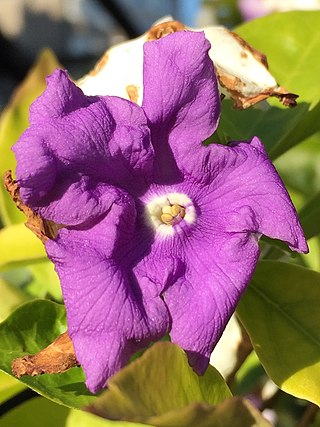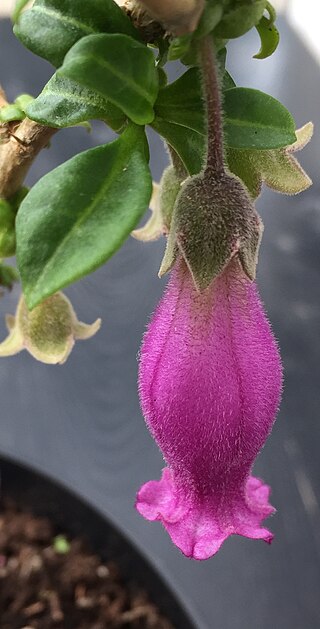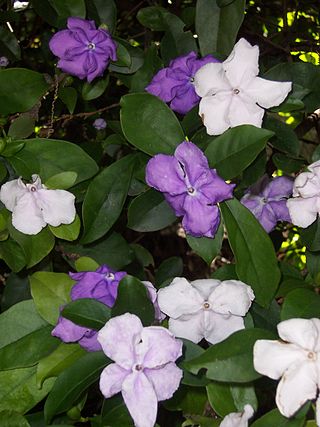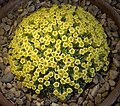
Nicotiana is a genus of herbaceous plants and shrubs in the family Solanaceae, that is indigenous to the Americas, Australia, Southwestern Africa and the South Pacific. Various Nicotiana species, commonly referred to as tobacco plants, are cultivated as ornamental garden plants. N. tabacum is grown worldwide for the cultivation of tobacco leaves used for manufacturing and producing tobacco products, including cigars, cigarillos, cigarettes, chewing tobacco, dipping tobacco, snuff, and snus.

Petunia is a genus of 20 species of flowering plants of South American origin. The popular flower of the same name derived its epithet from the French, which took the word pétun, 'tobacco', from a Tupi–Guarani language. A tender perennial, most of the varieties seen in gardens are hybrids.

The flowering plant genus Ipheion belongs to Allioideae, a subfamily of the family Amaryllidaceae. The World Checklist of Selected Plant Families no longer recognize the genus, regarding it as a synonym of Tristagma, although The Plant List accepts two species.

Calibrachoa is a genus of plants in the Solanaceae (nightshade) family. They are evergreen short-lived perennials and subshrubs with a sprawling habit, with small petunia-type flowers. They are found across much the same region of South America as petunias, from southern Brazil across to Peru and Chile, inhabiting scrub and open grassland.

Iochroma is a genus of about 34 species of shrubs and small trees belonging to the nightshade family Solanaceae. Species are native from Mexico to south Brazil. They are found in the forests of Mexico and South America. Their hummingbird-pollinated flowers are tubular or trumpet-shaped, and may be blue, purple, red, yellow, or white, becoming pulpy berries. The cupular (cup-shaped) calyx is inflated in some species. The leaves are alternate, simple, and entire.

Heimia is a genus of flowering plants in the loosestrife family, Lythraceae. It contains two or three species of closely related shrubs commonly known as sun opener or shrubby yellowcrest. They are native to the Americas, from northern Argentina north to the southernmost United States. The leaves are 2–5 cm long and 1 cm broad, entire, and variably arranged alternate, opposite or whorled on the stems. All species produce five-petaled yellow flowers. The plants have a history of medicinal use in a variety of American cultures. Several pharmacologically active alkaloids have been detected in the plants. The generic names honours German physician Ernst Ludwig Heim (1747–1834).

Brugmansia is a genus of seven species of flowering plants in the nightshade family Solanaceae. They are woody trees or shrubs, with pendulous flowers, and have no spines on their fruit. Their large, fragrant flowers give them their common name of angel's trumpets, adjacent to the nickname devil's trumpets of the closely related genus Datura.

Schizanthus, also called butterfly flower, fringeflower, poor-man's-orchid, is a genus of plants in the nightshade family, Solanaceae.

Brunfelsia is a genus of flowering plants belonging to subfamily Petunioideae of the nightshade family Solanaceae. The 50 or so species have been grouped into the three sections: Brunfelsia, Franciscea and Guianenses, which differ significantly in both distribution and characteristics, although molecular data have revealed that only two sections are natural (monophyletic), namely the Caribbean section Brunfelsia and a common section for all South American species. Linnaeus named the genus for the early German herbalist Otto Brunfels (1488–1534).

Grabowskia was a genus of flowering plants belonging to tribe Lycieae of subfamily Solanoideae of the nightshade family, Solanaceae. The sole remaining genus in tribe Lycieae is now Lycium, the box thorns, following the incorporation into this tribe of the genera
Grabowskia Schltdl. and Phrodus Miers.

Latua pubiflora(Griseb.) Baillon, is the single species of the monotypic genus LatuaPhil., endemic to the coastal mountains of southern Chile. A shrub or small tree to 10 m in height, bearing attractive, magenta-to-red, hummingbird-pollinated flowers, it is extremely poisonous – hallucinogenic (deliriant) in smaller doses – due to tropane alkaloid content and is used by Chilean machi (shamans) of the Mapuche–Huilliche people in traditional medicine, as a poison and to enter trance states. Its elegant flowers and yellow tomato-like fruit are attractive enough to merit its cultivation as an ornamental.

Fabiana imbricata, vernacular names pichi, palo piche, or false heath, is a species of flowering plant in the family Solanaceae, native to dry upland slopes in the foothills of the southern Andes of Chile and Argentina. Growing to 2.5 m tall and wide, it is a frost-hardy, heath-like evergreen mound-forming shrub. It has needle-like leaves and small white, tubular flowers in early summer.

Brunfelsia pauciflora is a species of flowering plant in the family Solanaceae, the nightshades. It is endemic to Brazil, and it is grown in cultivation. A shrubby perennial plant grown in gardens, its common names include today, tomorrow together, yesterday, today and tomorrow, morning-noon-and-night, kiss me quick, and Brazil raintree.

Fabiana is a genus of flowering plants in the nightshade family, native to dry slopes in western South America. They are evergreen shrubs or subshrubs, with needle-like leaves and profuse tiny tubular flowers in summer. The common name is false heath because the leaves superficially resemble those of the distantly related heaths. The species F. imbricata is cultivated as a common horticultural plant and a common herbarium specimen.
Timothy Charles Plowman was an ethnobotanist best known for his intensive work over the course of 15 years on the genus Erythroxylum in general, and the cultivated coca species in particular. He collected more than 700 specimens from South America, housed in the collection of the Field Museum of Natural History. The standard author abbreviation Plowman is used to indicate this person as the author when citing a botanical name.

Benthamiella is a genus of plants in the family Solanaceae, native to Patagonia in southern South America. Its species have been described as "attractive, small, cushion plants".

Petunia integrifolia, the violet petunia or violetflower petunia, is a species of wild petunia with violet-colored blooms. Petunia integrifolia is native to Argentina. P. integrifolia bears flowers approximately 1.5 inch in diameter and the plant is typically smaller and harder to cultivate than the well-known hybrid bedding Petunia now known correctly as Petunia × atkinsiana.

The Solanaceae, or the nightshades, are a family of flowering plants that ranges from annual and perennial herbs to vines, lianas, epiphytes, shrubs, and trees, and includes a number of agricultural crops, medicinal plants, spices, weeds, and ornamentals. Many members of the family contain potent alkaloids, and some are highly toxic, but many—including tomatoes, potatoes, eggplant, bell and chili peppers—are used as food. The family belongs to the order Solanales, in the asterid group and class Magnoliopsida (dicotyledons). The Solanaceae consists of about 98 genera and some 2,700 species, with a great diversity of habitats, morphology and ecology.
Pantacantha is a monotypic genus of flowering plants belonging to the family Solanaceae. The only species is Pantacantha ameghinoi.

Brunfelsia uniflora, the manac, is a species of flowering plant in the family Solanaceae. It is native to Monos island of Trinidad and Tobago, Venezuela, the Venezuelan Antilles, Guyana, Brazil, and northwest Argentina, and has been introduced to eastern Tropical Africa, Réunion, Mauritius, India, and Assam. A poisonous evergreen shrub typically 0.5 to 3 m tall, it is commonly cultivated as an ornamental, and as an ingredient in ayahuasca and other potions, usually under its synonym Brunfelsia hopeana.



























